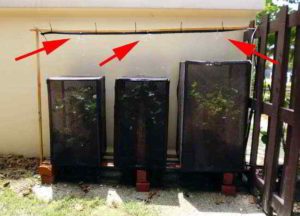Keeping Chameleons in Malaysia
Keeping chameleons in Malaysia, like all countries, has its own unique challenges. Here are some of the more common ones I have experienced.
Feeder Foods in Malaysia
Many pet shops sell crickets in Malaysia, primarily for fish and birds. The quality of these crickets is nothing short of horrendous! Their life expectancy is merely days and the shops often keep them in the most unhygienic conditions. If you must buy them from a pet shop, then look at the container to see how many dead and rotting crickets are at the bottom. Ask the pet shop owner what they feed the crickets. Leftover chicken rice is not the ideal gut food for a chameleon!
Some suppliers of clean crickets exist but you may want to consider breeding your own. So far, the only crickets I have found for sale are singing crickets. These are not silent and make a lot of noise!
You can often buy cockroaches – not house roaches – in small boxes or as colonies. In South Africa, none of my chameleons showed any interest in roaches. In Malaysia, they love them. I breed Turkistan and Dubia. Don’t use Dubias that are too large for the chameleon to swallow easily.
At some pet shops that sell birds, you might find freshly caught green grasshoppers. These make a good change from crickets and chameleons love them.
Plants for the cage
Ficus benjamina was the plant of choice in South Africa and every garden centre sold plants at low cost. In Malaysia, I haven’t seen any decent specimens at the right size. However, hibiscus is cheap and plentiful. Another difference I have seen is that my Veiled love hibiscus. I feed them on a variety of insects and yet I often need to replace the hibiscus plants after only a few weeks!
If you use any plants from a nursery, be careful about insecticides used. Regardless of what the nursery tells you, assume they have been sprayed. It is best to leave them outside for a couple of weeks and spray them heavily to remove any traces of poison.
The Climate in Malaysia

This is an interesting factor. So long as the Veiled chameleon is well watered AND not in direct sunlight for more than a few hours AND has a large, shady plant it can retreat into then keeping it outside is a great idea. In the shade, the cage will tend to be around 30c or slightly lower. If you spray heavily as the sun reaches the cage, the humidity will keep the temperature lower but they will still get the best UV light possible – sunlight.
Use common sense and you should be fine. Look at the photos of my set up for ideas. I keep my adult Veiled chameleons outside in Malaysia and they have thrived. I would not recommend keeping any other species outdoors permanently.
Seasonal variation in temperature is minimal and cannot replicate the vast changes seen in Yemen (or Madagascar) or even in South Africa.
Other things to look out for – cats and fogging.
Air Conditioning
Air con can be worse than the climate. It has been responsible for several chameleon fatalities. Most people do not have the facilities or situation to put their chameleon in the garden, so they keep them indoors.
Do not let the breeze from the air con blow onto the cage as may will chill the lizard and make it ill. Remember that air con in a room tends to be dry the air. If you keep your chameleon in an air conned room, you will need to ensure a proper routine of spraying. That’s not a quick spray from a water bottle but enough that the water runs down the leaves for several minutes. Consider automated systems like a Habba mister or something similar.
What temperature are you comfortable with? Is it the right one for the chameleon? 22 to 26c is a bit cold for a permanent set up. If you turn off your air con at night, then check your night time temperatures (when the lizard should be resting) are not higher than your daytime temperatures. This will stress and sicken your animal.
